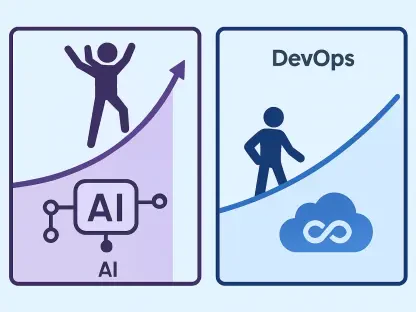What happens when the intricate, time-consuming process of building REST interfaces in the financial sector gets a high-tech makeover? In an industry where every second counts and compliance is paramount, a group of IT architects has turned to Artificial Intelligence, specifically Large Language Models (LLMs), to slash development time by a staggering 30%. This isn’t just a minor tweak—it’s a bold leap into uncharted territory, promising to redefine efficiency in one of the most regulated sectors. The stakes are high, and the potential rewards even higher, as this innovation addresses the painstaking task of crafting secure, compliant interfaces that connect critical systems.
The significance of this development cannot be overstated. Financial services rely on REST (Representational State Transfer) interfaces to ensure seamless communication between disparate applications, all while adhering to stringent architectural guidelines. With manual processes often riddling teams with errors and delays, the introduction of AI-driven automation offers a lifeline—a chance to boost productivity without compromising precision. This story dives into the heart of an experiment that’s reshaping how financial systems are built, exploring the triumphs, the hurdles, and the roadmap ahead for integrating AI into such a high-stakes environment.
Why AI Automation Is the New Frontier for Financial Interfaces
In the fast-paced world of finance, time is a currency as valuable as capital. Developing REST interfaces, which serve as the backbone for system integration, often consumes hours of meticulous manual effort—sometimes stretching from 2 to 10 hours per task. The push to automate this process using AI, particularly LLMs, emerges as a response to the growing demand for speed without sacrificing the rigorous standards that govern the sector. This shift represents more than just a technological upgrade; it’s a strategic move to keep pace with an industry that never sleeps.
The potential of AI in this space lies in its ability to transform raw technical analysis documents into structured Swagger definitions—a key component of REST interfaces. Early experiments with tools like ClaudeAI and ChatGPT revealed that what once took days could be condensed into hours, offering a glimpse of a future where developers focus on innovation rather than repetitive tasks. This frontier isn’t just about saving time; it’s about reimagining how financial institutions can operate under pressure while maintaining airtight compliance.
The ripple effect of such automation extends beyond individual projects. By reducing the burden on IT teams, resources can be redirected toward solving complex challenges or enhancing customer-facing solutions. As financial firms grapple with increasing regulatory scrutiny, the ability to streamline backend processes with AI becomes a competitive edge, positioning early adopters at the forefront of industry evolution.
The Critical Role of REST Interfaces in Finance
REST interfaces are the unsung heroes of financial systems, acting as secure conduits that enable different platforms to communicate effectively. Whether it’s transferring sensitive data between banking applications or ensuring real-time updates across trading platforms, these interfaces must adhere to exacting standards to prevent breaches and ensure interoperability. A single misstep in their design can lead to cascading failures, making their development a high-stakes endeavor.
The traditional approach to crafting these interfaces, often involving manual creation of detailed Swagger definitions, is notoriously slow and error-prone. Development teams face constant pressure to deliver under tight deadlines, all while navigating a maze of organizational rules and regulatory requirements. Non-compliance isn’t an option—errors can result in fines, security risks, or operational downtime, amplifying the need for a more reliable method.
This is where the urgency for automation becomes evident. With the volume of digital transactions growing exponentially, the demand for robust, quickly deployable interfaces has skyrocketed. Financial institutions can no longer afford the luxury of prolonged development cycles, setting the stage for AI to step in as a transformative force in addressing these systemic bottlenecks.
Inside the Experiment: How AI Transforms REST Automation
Delving into the specifics of this groundbreaking experiment, IT architects harnessed LLMs to convert complex technical documents into functional REST interfaces. The process began with feeding analysis content into AI tools, which then generated structured outputs like Swagger definitions. Initial results were striking—tasks that typically spanned hours were cut down by 30%, showcasing the raw power of automation in a field burdened by repetitive workflows.
The methodology was meticulously structured to maximize success. Architects broke the task into phases: first outlining the core interface structure, then layering in detailed specifications, and finally cross-checking for compliance with financial guidelines. This step-by-step approach minimized errors during early testing with dummy data, proving that even in a rule-heavy sector, AI could deliver measurable efficiency gains.
Real-world implications emerged quickly during these trials. For instance, a mock project that once demanded up to 10 hours of manual input was streamlined significantly, freeing up developers to tackle more strategic priorities. While the experiment focused on controlled scenarios, the tangible reduction in workload highlighted AI’s potential to reshape how financial systems are built, paving the way for broader application across live projects.
Voices from the Trenches: Balancing AI Potential with Pitfalls
Behind the impressive statistics lie the candid reflections of those who spearheaded this initiative. A lead architect noted, “The early wins were exciting, but as we scaled up, the cracks started showing—AI isn’t foolproof yet.” This honest assessment underscores the dual nature of the experiment: while time savings were real, LLMs struggled with maintaining consistency when faced with intricate rules or expanded prompts, often forgetting prior guidelines.
Industry observations echo these concerns, pointing to inherent limitations in current AI capabilities. For example, context window constraints—such as Copilot’s 8,000-token cap—hampered performance as tasks grew more complex. Stories from the team reveal instances where prompts failed to produce compliant outputs, necessitating manual corrections and reinforcing that human oversight remains indispensable in such a regulated field.
These insights paint a balanced picture of AI’s role in financial automation. The technology offers undeniable benefits, yet it demands vigilance to navigate its shortcomings. As architects grapple with these realities, their experiences serve as a cautionary tale for others eager to adopt similar solutions, emphasizing that innovation must be paired with pragmatism in high-stakes environments.
Practical Pathways to Integrate AI in Financial Automation
For organizations looking to replicate this experiment, actionable strategies drawn from the project’s lessons provide a clear starting point. Begin with small, manageable phases—focus on generating basic interface structures before adding intricate details, ensuring each step aligns with compliance requirements. This incremental approach helps curb errors and builds confidence in AI outputs over time.
Crafting precise prompts is another critical tactic. LLMs perform best when instructions are concise and focused, avoiding overload of their context capacity. Additionally, integrating regular human validation cycles is essential to catch inconsistencies, particularly in meeting regulatory standards, as full automation remains out of reach for now. These checkpoints act as a safety net in a sector where precision is paramount.
Scalability also merits attention. Developing customizable templates and adaptable prompts allows solutions to fit diverse client needs or varying guidelines, enhancing reusability across projects. By blending these practical steps with a commitment to continuous refinement, financial institutions can harness AI’s potential while mitigating risks, ensuring that automation serves as a reliable ally in navigating complex development landscapes.
Reflecting on a Pioneering Journey
Looking back, the journey of automating REST interfaces with AI in the financial sector stands as a testament to both ambition and resilience. The experiment carved out a path where efficiency soared, cutting development times by 30%, yet it also laid bare the limitations of current technology in handling intricate, rule-bound tasks. Each step, from early successes to sobering setbacks, offered invaluable lessons for an industry hungry for innovation.
Moving forward, the focus shifts to actionable refinement—enhancing LLM accuracy through better prompt engineering and exploring models with larger context capacities. Establishing robust consistency checks between technical inputs and outputs emerges as a priority to uphold compliance. Moreover, adapting these solutions for broader scalability through tailored templates promises to extend the benefits to diverse financial players. This pioneering effort, while not without flaws, sets a foundation for future advancements, urging the sector to embrace AI as a partner in progress while keeping a steady hand on the reins of oversight.









